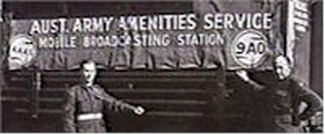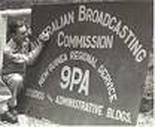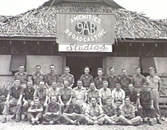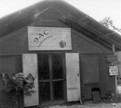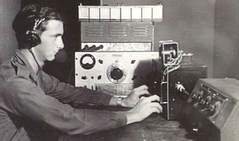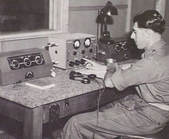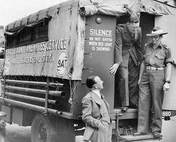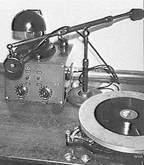AUSTRALIAN MILITARY WWII BROADCASTING STATIONS
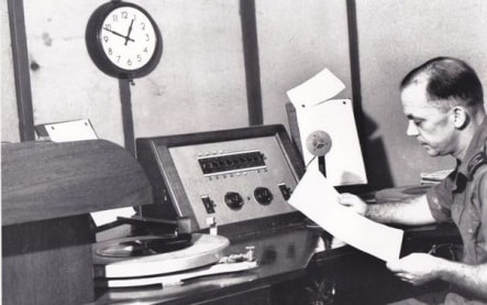
RAAF Milne Bay (T.P.N.G.) 26-01-1944. “R.A.A.F. Radio Milne Bay – The Voice of the Islands”. Established to entertain R.A.A.F. personnel at this T.P.N.G. air base on 1150 KHz. This was the first of the “Jungle Network” stations. On air 1200-1300 and 1800-2030 daily with a library of 180 records. Their Studio Manager was John West; later well-known on A.B.C. radio. Their Chief Announcer was Leon Becker from 2KM, plus announcers John Greathead from 2GZ, 2KA, and 4BU, and Sergeant F. Sheppard from 4QG and 4QR. Their equipment was ‘obtained’ from American service sympathisers. This station and personnel were moved to Nadzab in June 1944.
9PA Port Moresby (T.P.N.G.) 26-02-1944. Australian Army radio station using a 500 watt transmitter on 1250 KHz. operating at 250 watts, due to electricity restrictions. Controlled by Captain Robin Wood (enlisted from the A.B.C.). Their equipment was installed by technicians from the Australian Post Office, next to the A.W.A. coastal station VIG, with a 90 feet high tower. Opened by General Douglas Macarthur, and A.B.C. Director-General, Sir Charles Moses. The opening was relayed to all Australian A.B.C. stations. Its purpose was to entertain Australian and American troops towards the end of WWII. The callsign was changed to 9AA shortly after opening (Australian Army). Also had some programs in the Papuan Motu language.
On air 0630-0800, 1200-1400, and 1600-2200. News was relayed from the A.B.C. and also the American Armed Forces Radio Networks. Visiting on-air celebrities included Jack Benny, Jack Davey, and Bob Hope. Closed on 28-2-1946, with the transmitter equipment being maintained by the P.M.G., until taken over by the A.B.C. on 1-7-1946, with the callsign then changing back to 9PA. Also see 4PM 25-10-1935 and 9PA 1-7-1946, listed in the Queensland section. Photo is announcer Geoffrey Norton.
9PA Port Moresby (T.P.N.G.) 26-02-1944. Australian Army radio station using a 500 watt transmitter on 1250 KHz. operating at 250 watts, due to electricity restrictions. Controlled by Captain Robin Wood (enlisted from the A.B.C.). Their equipment was installed by technicians from the Australian Post Office, next to the A.W.A. coastal station VIG, with a 90 feet high tower. Opened by General Douglas Macarthur, and A.B.C. Director-General, Sir Charles Moses. The opening was relayed to all Australian A.B.C. stations. Its purpose was to entertain Australian and American troops towards the end of WWII. The callsign was changed to 9AA shortly after opening (Australian Army). Also had some programs in the Papuan Motu language.
On air 0630-0800, 1200-1400, and 1600-2200. News was relayed from the A.B.C. and also the American Armed Forces Radio Networks. Visiting on-air celebrities included Jack Benny, Jack Davey, and Bob Hope. Closed on 28-2-1946, with the transmitter equipment being maintained by the P.M.G., until taken over by the A.B.C. on 1-7-1946, with the callsign then changing back to 9PA. Also see 4PM 25-10-1935 and 9PA 1-7-1946, listed in the Queensland section. Photo is announcer Geoffrey Norton.
RAAF Nadzab (T.P.N.G.) 06-1944. This station and its personnel were originally established at Milne Bay. (Nadzab is approximately 45 kilometres from Lae). This radio station was moved to Madang in September 1944.
RAAF Madang (T.P.N.G.) 10-1944. “R.A.A.F. Radio Madang – The Voice of the Islands”. Established to entertain R.A.A.F. personnel at this T.P.N.G. air base using a 500 watt transmitter on 1130 KHz. and new studio equipment. Managed by Ric Havyatt (VK2PH), with technical assistance from E. Parris (2PK manager). Their Chief Announcer, Sergeant F. Sheppard, came from 4QG and 4QR. Other announcers were Alan Watson from 2CK and 2KO, plus Maurice Lockie from 3BO and John West (later both well-known on A.B.C. radio). News was relayed from Radio Australia. Transcription programs were provided by 2GB, 2UW and the American Armed Forces Radio Service. Plans to establish more RAAF radio stations were dropped when WWII ended.
? Ravenshoe 1944. Australian Army station at the Ravenshoe Army Base in North Queensland.
9AB Lae (T.P.N.G.) 1945. Australian Army station using 200 watts on 1070 KHz. The station was originally assembled from abandoned Japanese communication parts until new equipment was obtained. Lieutenant Terry Dear was their Commanding Officer (from 2GB, 2UW, 3AW, 3KZ, and the Colgate-Palmolive and Macquarie Radio Units). Prime Minister Chifley, visited the studio, with General (later Field Marshall) Thomas Blayney and Dr. Coombs, and broadcast live to the troops on Christmas Day 1945. They then broadcast two live plays by the Peter Finch drama group. Their announcers were Keith Smith from 3DB, 2BL, and 2GB, Ian Neil from 4BH, 4SB, and 4BK, and Dudley Simpson.
9AC Torokina (T.P.N.G.) 15-03-1945. Australian Army station on Bougainville Island. On air daily 0630-0830, 1030-1400, and 1630-2200 using a 200 watt transmitter on 1280 KHz. Their Chief Announcer was Warrant Officer Maurice Callard from 3DB, plus Eric Spence from 3AK and Brian Carlton from 3XY. Their record library was inherited from the American Forces Radio Service Jungle Network station WVTI. On 7-8-1945, knowing that Japanese soldiers on the island were listening, they broadcast the consequences of the atomic bomb drops on Japan, using the Japanese language. Prime Minister Chifley visited Torokina and did a live broadcast. Closed early 1946.
9AE Jacquinot (T.P.N.G.) 05-1945. Australian Army station situated in New Britain using a Tasma 200 watt transmitter on 1370 KHz. Their Commanding Officer was Lieutenant Alan Brown from 7HO and 7HT. Their announcer was Sergeant R.P. (“Rollee”) Barlee from 3UZ and 3XY. Their Engineer was Craftsman Bill Morrison from 7HO. Installed in a hospital storage shed, with two microphones and two 78 R.P.M. turntables. On air 0630-0800, 1100-1400, and 1700-2230. A concert in Jacquinot for the troops featuring Gracie Fields was broadcast live. This station was later moved to Rabaul.
RAAF Madang (T.P.N.G.) 10-1944. “R.A.A.F. Radio Madang – The Voice of the Islands”. Established to entertain R.A.A.F. personnel at this T.P.N.G. air base using a 500 watt transmitter on 1130 KHz. and new studio equipment. Managed by Ric Havyatt (VK2PH), with technical assistance from E. Parris (2PK manager). Their Chief Announcer, Sergeant F. Sheppard, came from 4QG and 4QR. Other announcers were Alan Watson from 2CK and 2KO, plus Maurice Lockie from 3BO and John West (later both well-known on A.B.C. radio). News was relayed from Radio Australia. Transcription programs were provided by 2GB, 2UW and the American Armed Forces Radio Service. Plans to establish more RAAF radio stations were dropped when WWII ended.
? Ravenshoe 1944. Australian Army station at the Ravenshoe Army Base in North Queensland.
9AB Lae (T.P.N.G.) 1945. Australian Army station using 200 watts on 1070 KHz. The station was originally assembled from abandoned Japanese communication parts until new equipment was obtained. Lieutenant Terry Dear was their Commanding Officer (from 2GB, 2UW, 3AW, 3KZ, and the Colgate-Palmolive and Macquarie Radio Units). Prime Minister Chifley, visited the studio, with General (later Field Marshall) Thomas Blayney and Dr. Coombs, and broadcast live to the troops on Christmas Day 1945. They then broadcast two live plays by the Peter Finch drama group. Their announcers were Keith Smith from 3DB, 2BL, and 2GB, Ian Neil from 4BH, 4SB, and 4BK, and Dudley Simpson.
9AC Torokina (T.P.N.G.) 15-03-1945. Australian Army station on Bougainville Island. On air daily 0630-0830, 1030-1400, and 1630-2200 using a 200 watt transmitter on 1280 KHz. Their Chief Announcer was Warrant Officer Maurice Callard from 3DB, plus Eric Spence from 3AK and Brian Carlton from 3XY. Their record library was inherited from the American Forces Radio Service Jungle Network station WVTI. On 7-8-1945, knowing that Japanese soldiers on the island were listening, they broadcast the consequences of the atomic bomb drops on Japan, using the Japanese language. Prime Minister Chifley visited Torokina and did a live broadcast. Closed early 1946.
9AE Jacquinot (T.P.N.G.) 05-1945. Australian Army station situated in New Britain using a Tasma 200 watt transmitter on 1370 KHz. Their Commanding Officer was Lieutenant Alan Brown from 7HO and 7HT. Their announcer was Sergeant R.P. (“Rollee”) Barlee from 3UZ and 3XY. Their Engineer was Craftsman Bill Morrison from 7HO. Installed in a hospital storage shed, with two microphones and two 78 R.P.M. turntables. On air 0630-0800, 1100-1400, and 1700-2230. A concert in Jacquinot for the troops featuring Gracie Fields was broadcast live. This station was later moved to Rabaul.

9AE Rabaul (T.P.N.G.) 1945. Australian Army station on the island of New Britain
using 200 watts on 1370 KHz. This station was previously located at Jacquinot.
9AI ? 1945. Australian Army station using a 10 watt transmitter on 980 KHz. which left Brisbane by ship in October 1945 for an unknown destination, carrying 1,800 records.
RAAF Higgins Field 08-1945. “R.A.A.F. Radio”. Established to entertain R.A.A.F. personnel at their air base near Bamaga in Queensland with 100 watts on 1470 KHz. Their announcer was Doug Elliott from 3KZ, 3UZ, 3AW, and 3XY.
9AP Labuan (Borneo) 08-1945. An Australian Army station using ten watts. Their announcers included Sergeant Ken Austin from 3UL, (later 2GZ and 3SR) and Frank Bennett (later 2KY, 2GB, and 2UE). On 27-8-1945 they broadcast a concert featuring Gracie Fields entertaining the troops. Only on air for a few weeks until the 9AF equipment arrived (see 9AF 21-11-1945). Prior to this station, the Australian Army had been using a 50 watt transmitter captured from the Japanese, which had used the callsign JL2.
9AG Balikpapan (Borneo) 10-1945. Australian Army station used to entertain the A.I.F. (7th Division) in Borneo using a 200 watt transmitter and two 90 feet high towers. Their Commanding Officer was Eric McRae from 3SR and 7HO (he later started 9AD in Moratai). Their announcers were Pat Barton from 2KO and Russ Tyson (later 4KQ and 4QG). The station was given to the Dutch authorities on 1-3-1946 after the Australian troops left. Prior to 9AG, Australian troops arrived on the HMAS Kanimbla in July. They first established a station using a 12 watt Army shortwave transmitter on 7,960 KHz. in August with the callsign 7KM.
9A? Weston (Borneo) 1945. Australian Army station used to entertain Australian troops in Borneo.
using 200 watts on 1370 KHz. This station was previously located at Jacquinot.
9AI ? 1945. Australian Army station using a 10 watt transmitter on 980 KHz. which left Brisbane by ship in October 1945 for an unknown destination, carrying 1,800 records.
RAAF Higgins Field 08-1945. “R.A.A.F. Radio”. Established to entertain R.A.A.F. personnel at their air base near Bamaga in Queensland with 100 watts on 1470 KHz. Their announcer was Doug Elliott from 3KZ, 3UZ, 3AW, and 3XY.
9AP Labuan (Borneo) 08-1945. An Australian Army station using ten watts. Their announcers included Sergeant Ken Austin from 3UL, (later 2GZ and 3SR) and Frank Bennett (later 2KY, 2GB, and 2UE). On 27-8-1945 they broadcast a concert featuring Gracie Fields entertaining the troops. Only on air for a few weeks until the 9AF equipment arrived (see 9AF 21-11-1945). Prior to this station, the Australian Army had been using a 50 watt transmitter captured from the Japanese, which had used the callsign JL2.
9AG Balikpapan (Borneo) 10-1945. Australian Army station used to entertain the A.I.F. (7th Division) in Borneo using a 200 watt transmitter and two 90 feet high towers. Their Commanding Officer was Eric McRae from 3SR and 7HO (he later started 9AD in Moratai). Their announcers were Pat Barton from 2KO and Russ Tyson (later 4KQ and 4QG). The station was given to the Dutch authorities on 1-3-1946 after the Australian troops left. Prior to 9AG, Australian troops arrived on the HMAS Kanimbla in July. They first established a station using a 12 watt Army shortwave transmitter on 7,960 KHz. in August with the callsign 7KM.
9A? Weston (Borneo) 1945. Australian Army station used to entertain Australian troops in Borneo.
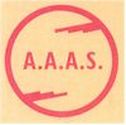
9A? Weston (Borneo) 1945. Australian Army station used to entertain Australian troops in Borneo.
9AF Tarakan (Borneo) 01-11-1945. Australian Army station installed temporarily before being moved to Labuan. The equipment was transported from Sydney to Tarakan on board the USS Henry Rice. The 6th Division Concert Party Band hosted their opening broadcast with a live performance.
9AL Rabaul (T.P.N.G.) 1945. Australian Army station on the island of New Britain on 1030 KHz.
9AL Fauro Island (T.P.N.G.) 1945. Australian Army station using a 10 watt transmitter on 1030 KHz.
9AF Labuan (Borneo) 08-11-1945. Australian Army station using a BC 200 transmitter (first tested at Tarakan). Their Commanding Officer was 5AD and 5RM announcer Lieutenant K. Crossman. Their chief announcer was Warrant Officer Bert Wooley from 5DN. Other announcers included Ken Austin from 9AP, 2GZ, 3SR, and 3UL, and Warrant Officer Chris Lymons from 5CL. Their Chief Technician was Ernie Higgenbottom from 3AR.
9AD Aitape (T.P.N.G.) 1945. Australian Army station using 200 watts on 1440 KHz, managed by Eric McRae from 9AG, 3SR, and 7HO. Their announcers were Laidley Mort from 3AR/3LO, and 3UZ, Arthur Pettet from 2UE, and Norm Spencer from 3DB.
9AJ Wewak (T.P.N.G.) 1945. Australian Army station. The entire station was built into a small truck except for their ten watt transmitter (1030 KHz.) which was at Cape Wom. Their announcer was Ian Neil from 4BH, 4SB, and 4BK (earlier on 9AB and later well-known on the A.B.C.). Created radio history by broadcasting live the first Japanese war crime trials in Papua New Guinea.
9AJ Solomon Islands 1945. Australian Army station at Bosley Field, Bougainville on 960 KHz. They took over from an American Armed Forces Mosquito Network station. Their station manager was Sergeant A. George from 2GZ: their Program Manager was John Rann from 3CS, and their announcers were Garfield Madders, T. Roberts, and Sergeant Bray. They also had a studio mascot cat called ‘Mike’. Their most requested record was “I’ll be spending Christmas with the old folks”.
9AO Jesselton (Sabah) 01-1946. Australian Army station using a 10 watt transmitter on 980 KHz. One of several mobile radio stations built into a three ton truck. The Officer in Charge and chief announcer was Fred Edwards from 6WF, assisted by Al Scown (who later worked at 3MA, 3BO, and 2AY). Moved the station to Moratai on 4-3-1946 as 9AD. Plans to move a new station (9AP from Labuan), to Jesselton, were cancelled when our troops moved out. (Jesselton was renamed Kota Kinabalu in 1968).
9AD Morotai (Dutch East Indies) 04-03-1946. Australian Army station using a 90 feet high tower and 10 watts (previously located at Jesselton as 9AO). Later increased power to 200 watts. Their Chief Engineer was Arthur Pettet from 2UE, assisted by R.A.A.F. radio technician Malcolm Philps. Announcers included Laidley Mort from 3LO (and later 3UZ), plus Warrant Officers Tom Miller from 3XY, and Norm Spencer from 3DB (and later GTV-9 TV), and Russ Tyson (later from 4KQ and 4QG). Their station theme was “Thanks for the Memories” by Bob Hope. They had 1,600 records in their library; however, several thousand records were stolen in transit to the station. Their Commanding Officer was Eric McRae from 3SR and 7HO (later TVT-6 TV), who had earlier established 9AG. After The War, the equipment was sold to a Port Moresby cinema.
9AF Tarakan (Borneo) 01-11-1945. Australian Army station installed temporarily before being moved to Labuan. The equipment was transported from Sydney to Tarakan on board the USS Henry Rice. The 6th Division Concert Party Band hosted their opening broadcast with a live performance.
9AL Rabaul (T.P.N.G.) 1945. Australian Army station on the island of New Britain on 1030 KHz.
9AL Fauro Island (T.P.N.G.) 1945. Australian Army station using a 10 watt transmitter on 1030 KHz.
9AF Labuan (Borneo) 08-11-1945. Australian Army station using a BC 200 transmitter (first tested at Tarakan). Their Commanding Officer was 5AD and 5RM announcer Lieutenant K. Crossman. Their chief announcer was Warrant Officer Bert Wooley from 5DN. Other announcers included Ken Austin from 9AP, 2GZ, 3SR, and 3UL, and Warrant Officer Chris Lymons from 5CL. Their Chief Technician was Ernie Higgenbottom from 3AR.
9AD Aitape (T.P.N.G.) 1945. Australian Army station using 200 watts on 1440 KHz, managed by Eric McRae from 9AG, 3SR, and 7HO. Their announcers were Laidley Mort from 3AR/3LO, and 3UZ, Arthur Pettet from 2UE, and Norm Spencer from 3DB.
9AJ Wewak (T.P.N.G.) 1945. Australian Army station. The entire station was built into a small truck except for their ten watt transmitter (1030 KHz.) which was at Cape Wom. Their announcer was Ian Neil from 4BH, 4SB, and 4BK (earlier on 9AB and later well-known on the A.B.C.). Created radio history by broadcasting live the first Japanese war crime trials in Papua New Guinea.
9AJ Solomon Islands 1945. Australian Army station at Bosley Field, Bougainville on 960 KHz. They took over from an American Armed Forces Mosquito Network station. Their station manager was Sergeant A. George from 2GZ: their Program Manager was John Rann from 3CS, and their announcers were Garfield Madders, T. Roberts, and Sergeant Bray. They also had a studio mascot cat called ‘Mike’. Their most requested record was “I’ll be spending Christmas with the old folks”.
9AO Jesselton (Sabah) 01-1946. Australian Army station using a 10 watt transmitter on 980 KHz. One of several mobile radio stations built into a three ton truck. The Officer in Charge and chief announcer was Fred Edwards from 6WF, assisted by Al Scown (who later worked at 3MA, 3BO, and 2AY). Moved the station to Moratai on 4-3-1946 as 9AD. Plans to move a new station (9AP from Labuan), to Jesselton, were cancelled when our troops moved out. (Jesselton was renamed Kota Kinabalu in 1968).
9AD Morotai (Dutch East Indies) 04-03-1946. Australian Army station using a 90 feet high tower and 10 watts (previously located at Jesselton as 9AO). Later increased power to 200 watts. Their Chief Engineer was Arthur Pettet from 2UE, assisted by R.A.A.F. radio technician Malcolm Philps. Announcers included Laidley Mort from 3LO (and later 3UZ), plus Warrant Officers Tom Miller from 3XY, and Norm Spencer from 3DB (and later GTV-9 TV), and Russ Tyson (later from 4KQ and 4QG). Their station theme was “Thanks for the Memories” by Bob Hope. They had 1,600 records in their library; however, several thousand records were stolen in transit to the station. Their Commanding Officer was Eric McRae from 3SR and 7HO (later TVT-6 TV), who had earlier established 9AG. After The War, the equipment was sold to a Port Moresby cinema.
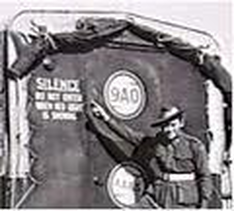
9AO Rabaul (T.P.N.G.) 1946. Australian Army station on the island of New Britain on 980 KHz.
9AT Kure (Japan) 1946. Australian Army station used to entertain BCOF (British Commonwealth Occupational Forces) in Japan using 200 watts on 1470 KHz. Also relayed to 10 watt mobile stations 9AM, 9AQ, 9AR, and 9AV. Their Commanding Officer was Val Woodland from 4QG, 4BC, 4GR, and 4BU. This station was later handed over to the American Armed Forces Radio Network as WVTV.
NOTE re WWII Army stations: See 4QR Brisbane (7-1-1938), 9AP Sydney and 9AF Melbourne (1945), plus 5AL Adelaide River and 5DR Darwin (1944) included in their respective State listings.
All the Army stations were operated by the Australian Army Amenities Service to provide entertainment for Australian servicemen.
9AT Kure (Japan) 1946. Australian Army station used to entertain BCOF (British Commonwealth Occupational Forces) in Japan using 200 watts on 1470 KHz. Also relayed to 10 watt mobile stations 9AM, 9AQ, 9AR, and 9AV. Their Commanding Officer was Val Woodland from 4QG, 4BC, 4GR, and 4BU. This station was later handed over to the American Armed Forces Radio Network as WVTV.
NOTE re WWII Army stations: See 4QR Brisbane (7-1-1938), 9AP Sydney and 9AF Melbourne (1945), plus 5AL Adelaide River and 5DR Darwin (1944) included in their respective State listings.
All the Army stations were operated by the Australian Army Amenities Service to provide entertainment for Australian servicemen.
9AO 9PA 9AB 9AC
9AE CONTROL ROOM 9AF STUDIO 9AT KURE JAPAN 9AT STUDIO
MAIN REFERENCES: RAAF radio technician Malcolm Philps. * State Library Sydney. * Historical Radio Society of Australia. Australian War Memorial. * Adrian Peterson, Editor, Adventist World Radio and Wavescan * www.trove.nla.gov.au * Radio Heritage Foundation, New Zealand (www.radioheritage.net). * A.A.A.S. announcers John West, Dudley Simpson and Maurice Lockier,
